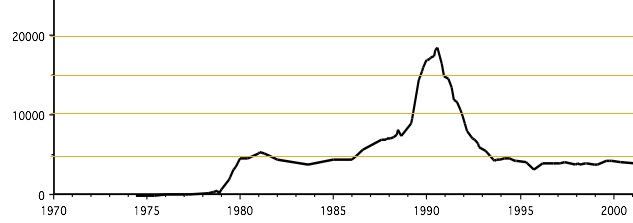This graph shows the approximate number of members of the formal political party from 1974 through to 1999.

Please note that the graph has been lifted as an image from a powerpoint slide - I do not yet have access to the source data. The scale is such that the thickness of the black line represents about 100 members, and if you click on the image to enlarge it you will see that the line itself has been displaced down with respect to the Y axis (membership was not in negative numbers up until 1978!). It is the overall shape and approximate numbers that are important. As we acquire accurate figures we will replace the image and provide a data table for those obsessed with knowing exactly how many party member there were at a given date...
In a sense the first surge in potential membership took place in 1972 when "hundreds, possibly approaching a thousand"1 (the exact number was never known) of people responded to the publication of Blueprint for Survival with requests to join. As with all subsequent jumps in membership, lack of capacity to deal with the rush and convert the potential members into a political force stymied development. In 1972 the responses were simply stored in cardboard boxes until handed over to PEOPLE 2 years later (Feb'74) when MS merged into PEOPLE. By then the caravan had moved on, and there were more immediate problems of standing in two general elections and creating a party organisation.
From the beginning in 1973 membership initially hovered around the 100 mark and then rose steadily to about 500 after the change of name in 1975. In March 1978 it stood at about 373 "with applications being received daily"2, and by the time the '79 election was in sight it was 500. The decision to field over 50 candidates in the 1979 general election and thus be entitled to a party election broadcast (PEB) certainly paid off. Although the results were not particularly good - averaging 1.5% in the constituencies where Ecology stood - the publicity resulted in the first surge in membership which increased 10-fold to just over 5000 within a year.
Throughout the first half of the 80's membership held at around 5000. The party took on a more radical flavour with the influx of a new younger generation who sometimes clashed with the traditionalists view of an electoral and parliamentary route to a green society. The creation of the SDP shifted media attention away to a different type of new politics.
In 1983 membership dipped slightly, but the success of the German Greens which was widely reported with the 1984 European election results, encouraging local election results, minor publicity around the 1987 general election (largely thanks again to the PEB), the growth of green movement politics and the change of name from an 'ology' to a colour all perhaps contributed to a gradual rise in numbers to over 7000 in 1988.
It is worth remembering that during this period there were only four television channels available, audiences were huge with over a third of the population watching the most popular shows, and crucially PEBs were shown simultaneously on all four channels, so despite the surge in electricity demand as the nation went to put on its kettles, they were seen by very large numbers of people.
At the time of the 1989 election membership had already reached 10,000 and over the following year it continued to rise. peaking at just off 20,000 in late 1990.
However the party lacked the organisation to involve and retain the new members, internal strife didn't help, and membership numbers started to slide from mid 1990 as many were disappointed that the high Green euro vote didn’t lead to tangible political gains and many new members simply failed to renew. Some did actively resign - particularly where activists resign or publicly step back from active involvement this has a knock-on effect of other "armchair" members loosing interest.
Media attention, which had been intense and increasingly critical following the election, also faded away as the mainstream parties tried to put on green clothes. All of this contributed to numbers continuing to fall through to 1995 when they dipped below 4000.
And there they remained, hovering around the pre-surge level of 4 to 5 thousand through the remainder of the 90s. Even the election of the first UK Green MEPs in 1999 failed to immediately boost numbers and it wasn't until 2002 that a slow recovery started.
For comparison the three main parties membership during the period 1970 to 2000 was declining. The Conservatives started around 1 million and were down to 400 thousand by 2000. Labour dropped from 700 to 350 thousand and the Liberals from 200 to around 50 thousand.
The political greens remained a tiny force throughout.
